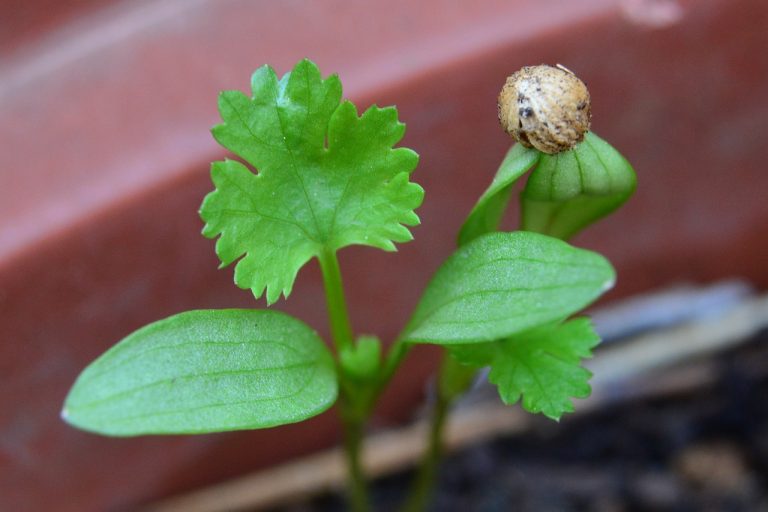Are you planning to grow Cilantro but don’t know how many plants you can fit in a given area? Well, you’re in luck! This article will discuss how many cilantro plants per square foot are appropriate for optimal growth and yield.
Later, we will discuss the factors you should consider when spacing your cilantro plants. At last, I will give a few tips and tell you how you can make a cilantro square-foot Garden.
How Many Cilantro Plants Per Square Foot?
As per Old Farmer’s Almanac, you can plant cilantro seeds 1-2 inches apart in rows 12 inches apart. Therefore you can grow roughly nine Cilantro per square foot. However, space them slightly further apart if you are planting cilantro seedlings. I’m saying this because it will help them grow and spread out without overcrowding each other and competing for resources.
Note: If you’re aero gardening, read and learn how many cilantro seeds per aerogarden pod?
You should know that every Garden is different, and you will also want to find out the number of cylinders you can grow per square foot for your Garden. Therefore, If you plan to plant Cilantro directly, consider its size to determine how many plants to fit per square foot.
Nevertheless, as per the University of Illinois Extension, your Cilantro can grow up to 2 feet in height and 1 foot in width. Additionally, you’ll have to consider the purpose of your cilantro plants when determining how many to plant per square foot.
If you’re growing Cilantro for its leaves, you should plant more densely to encourage the growth of more foliage. However, if you’re growing Cilantro for its seeds, space them further apart to allow them to develop correctly, as I told you earlier.
Overall, the number of cilantro plants you can fit per square foot depends on several factors, like the size of the plant, the spacing requirements, and the purpose of the plant.
Below I will talk about five elements, including these three in-depth, to help you experiment with different spacing techniques until you find the optimal number of cilantro plants per square foot for your Garden.
5 Factors Affecting The Spacing Of Cilantro Plants

It would be best if you never overlooked this factor, as it can directly affect the overall health, growth, and yield of your Cilantro. Below I am mentioning five factors you must consider when experimenting with different techniques.
Plant Size
As per UIE, cilantro plants can grow up to 2 feet in height and 1 foot in width, so you should always consider the plant size as a crucial factor when spacing them. When you are spacing your cilantro plants, provide enough space between each plant to allow them to grow and spread out without overcrowding each other.
Soil Quality
Do you know soil quality can also impact how many cilantro plants successfully thrive per square and give you the desired result? Since soil quality can also affect the spacing of cilantro plants, you should first treat your soil with organic compost and Epsom salt.
You should know that Cilantro needs a soil pH between 6.0 and 7.0. Also, note that Cilantro thrives in well-draining soil rich in organic matter. First, ensure that your soil has the right nutrient content and drainage capacity. If the soil is rich in nutrient content to support as many plants as you are considering experimenting, you can successfully grow Cilantro and expect better results.
Sun Exposure
Cilantro requires adequate Sunlight to grow and develop appropriately like any other plant. According to the NYBG, most Cilantro needs at least 6 hours of sunlight daily.
However, this may also vary depending on the variety of Cilantro you are growing and your region’s specific climate. I highly recommend you consider the location of your Garden and the amount of Sunlight it will receive in a day when spacing your cilantro plants.
Climate
Yes, the climate can also impact the spacing of cilantro plants. You might already know that Cilantro is a cool-season crop that thrives in temperatures between 50 to 85 degrees Fahrenheit. Therefore, If you live in a warmer climate, space your cilantro plants further apart. This will help ensure all your cilantro plants have enough air circulation to prevent fungal diseases.
Purpose of the Plant
Finally, as I said earlier, the cilantro plant’s purpose can also impact its spacing. If you’re growing Cilantro for its leaves, you need to space the plants closer together to encourage the growth of more leaves.
However, if you’re growing Cilantro for its seeds, space the plants further apart to allow them to develop correctly. As per the University of Florida IFAS Extension, your cilantro plants grown for seed production should be spaced at least 8 inches apart.
3 Other Tips To Keep In Mind When Spacing Cilantro

If you still have problems spacing cilantro plants, below, I am giving you a few additional tips to keep in mind that will help you ensure healthy growth and a bountiful harvest.
- If you’re starting your cilantro plants from seed, thinning out the seedlings once they grow is essential. You must remove any extra seedlings too close together to allow for proper growth. Also, as per the University of Utah Extension, your cilantro seedlings should be thinned 2-3 inches apart.
- As I told you earlier, Cilantro plants require at least 6 hours of Sunlight per day to grow properly; you should plant your Cilantro in a sunny location or provide supplemental light if necessary.
- Cilantro plants need consistent moisture to grow correctly. But prevent waterlogged cilantro plants by adhering to a proper watering schedule. You should know that the University of Illinois Extension recommends watering cilantro plants deeply once a week or more frequently in hot or dry weather.
How To Make Cilantro Square Foot Garden?
- Since Cilantro requires at least 6 hours of Sunlight per day to grow properly, you should choose a sunny location for your Garden. If you don’t have a bright spot, you can use artificial lighting to provide the necessary light.
- You need to create a square-foot garden by building a raised garden bed. As per Old Farmer’s Almanac, your square foot garden bed should be 4 feet by 4 feet, with 16 square feet of growing space.
- If you want to build a garden bed frame, choose materials like lumber, bricks, or cinder blocks.
- Since Cilantro prefers well-draining soil with a pH between 6.0 and 7.5, you should prepare your soil with compost or other organic matter to improve drainage and fertility.
- Now you must divide the garden bed into 16 equal square sections, each measuring 1 square foot. I will highly recommend you use a string to create a team. Alternatively, you can use any other markers to make the sections.
- Plant the Cilantro: According to SFGate, you can plant up to 4 cilantro plants per square foot in a square foot garden. I use your like to grow my cilantro seeds in the center of each section while spacing them out evenly.
- Lastly, it would be best if you watered the Cilantro regularly. Make sure to keep the soil consistently moist but not soggy. You also need to fertilize the Cilantro with a balanced fertilizer every 4-6 weeks, as it will help encourage healthy growth.
Also Read
- Cilantro Leaves Turning Red:7 Possible Reasons & 3 Risks
- WHAT DOES CILANTRO LOOK LIKE WHEN IT SPROUTS?
- 3 Tiny Bugs On Cilantro Plant (+Pics, Signs & Treatment)
Conclusion
As I told you, you could plant roughly nine Cilantro per square foot. But if you are planting cilantro seeds, you should consider spacing them further apart. If not done correctly, you might notice Cilantro Seedlings Falling Over.
While doing so, make sure also to consider the soil quality purpose, climate, sun, exposure, and plant size. All this can affect how much Cilantro you can successfully grow for your expected result in your Garden.
I tried my best to give you all the information on how many cilantro plants per square foot you can grow. If you find the article helpful, then consider sharing it.
Your share will help many people learn about the fundamentals they should consider to make the most out of their Cilantro square-foot Garden. Do check our other articles on cilantro care and management. See you in the next post, till then, take care and goodbye.






